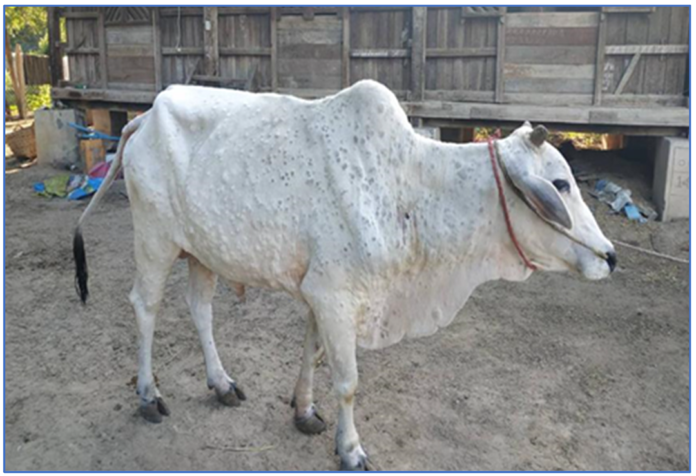At the Thokar Niaz entrance to Lahore only a stone’s throw away from the toll plaza, Muhammad Saleem* was stopped at a make-shift check-post. The officers manning it were neither police nor paramilitary. They belonged to the Punjab Livestock Department.
Every year for the past two decades, Saleem and his family have been rearing livestock and bringing it to larger cities like Lahore and Faisalabad to sell them as sacrificial animals for Eid. “There’s always something or the other. The livestock department makes sure to make our lives difficult each year. But it was different on this occasion. We were told that small bribes were not cutting it anymore and cows were being turned back and not allowed in the city,” he explains.
The reason? Lumpy Skin Disease – better known as LSD. The disease had rapidly been spreading through Sindh and KP and had entered Punjab as well. With the inflow of livestock into urban centres on the occasion of Eid, the fear was that Eid would turn into a super-spreader event and also put into circulation bad meat and infect the milk-supply of a lot of peri-urban dairy farmers that live on the edge of the city.
“We were told to be vigilant this time. So I bought vaccines. I vaccinated nearly all of my livestock but could not get it for all of the cows because a 100 ml vial costs as much as Rs 44,000 and we are already operating on thin margins and the whims of buyers,” says Saleem.
But when they finally got to the checkpost, the livestock department officials simply cast a quick glance at the cars that Saleem’s animals were being brought in, they checked a few ears, flashed a phone torchlight on the hides of a few of the cows, and let them go after signing and stamping a few papers. Saleem realised quickly that the officials were tired and not staffed well enough to do this job diligently.
“We all know how bad the heat has been. These men doing the inspections were sweaty, cranky, and exhausted. They didn’t have the time and energy to get on every vehicle and inspect each animal. So I called my brother and told him when he brings the next batch of animals, there was no need to go through the expense of vaccinating them. Besides, if we did get caught there were solutions. You can get a NADRA registered Covid-vaccination card here for Rs 15,000 for people. It isn’t like getting these documents for animals is any harder.”
That, in short, is the reality of how LSD was handled on the occasion of Eid ul Adha. The livestock department under checked animals to deflate numbers and create a false sense of calm. They also told people the meat and milk from these animals was safe to consume even though this is not the recommended practice.
The results in the immediate aftermath of Eid are already chock-full of disasters. For the past few years, leather imports had been down because of Covid related lockdowns. This year, with cases low around Eid and no lockdown, the industry was expecting imports worth $1 billion. However the presence of LSD means they will not clear over $950 million in exports and may even end up lower than that. A lot of the hides they are getting are infected and that means they are completely unusable. The more than five million dairy and meat farmers in the country are also being hit hard by LSD. Initially, LSD had been striking dairy farms in rural areas but with the advent of Eid more cases have started emerging in small-scale dairy farmers operating on the outskirts of cities like Lahore. That is because a large amount of the milk supply of Urban centres particularly from ‘gawalas’ that provide fresh milk comes from small dairy farm setups in peri-urban locations.
The true impact of Eid on the spread of LSD will make itself known over the coming few weeks. Because of the lack of oversight and the livestock department’s complicity in trying to tamp down the fear, there is no way of determining exactly what this effect is but it could prove disastrous.
What is LSD?
A viral disease, LSD has killed millions of cows and left the livestock industry in Africa, Europe, Israel, India and Afghanistan reeling before it finally reached Pakistan. By now, it has infected and killed thousands of animals in Pakistan as well.
The vector-borne, transboundary disease found among cattle and water buffaloes, spreads primarily through biting insects such as mosquitoes and ticks, was first discovered among livestock in Zambia, in 1929. It causes the cattle to suffer from “high temperature, much discomfort and loss of milk production.
Veterinarians seem split on whether it is alright to consume the meat and milk of cows affected by this disease. What is a reality for farmers is that milk production is significantly lowered in cows that have the disease, their hides become unsellable if they are slaughtered for meat. For consumers, it is not possible to know whether the milk or meat they are about to consume came from a diseased animal – a right that they have regarding what they are putting in their bodies.
Where did the virus come from?
Dr. Asif Rafique, Director Communications, Livestock and Dairy Development Department, Punjab, informed Profit that the virus was transmitted from Indian animals in Pakistan. “In fact, in the Cholistan area, cattle sometimes cross the border from India. It seems to us that from there an animal entered Pakistan’s territory which was infected and then as the infected cattle roamed the area, the virus spread from the rest of the cattle,” he claimed.
Asif also believes that infected cattle from the Afghanistan border and the Iran border could have a chance to enter Pakistan’s territory. Cows wandering in from neighbouring countries is not an unusual occurrence. Animals, of course, do not have a sense of borders or immigration. But LSD has not been reported in Pakistan before but has been an issue in India nearly five years ago when it first started to be reported.
Often, when a cow from across the border wanders into Pakistan, some farmer thanks his luck and takes the infected animal with him and includes it in his herd from where the rest of his animals catch the disease.
Dr. Asim Khalid, a senior veterinarian from Punjab, informed Profit that the disease was first diagnosed in Africa in 1929, after which the disease spread to India, Sri Lanka, Indonesia and then to Pakistan. “Initially, cattle breeders and veterinarians did not know that the Lumpy Skin virus had arrived in Pakistan. Due to this lack of knowledge, the virus spread widely. There is no chance of transmitting the Lumpy virus to humans because there are no receptors for the disease in humans. In order for any disease to be transmitted, it is essential that the organism has receptors for the disease. Lumpy skin disease receptors are not present in humans so they are not transmitted to humans. It cannot be even transmitted through consumption of meat and milk. Beef and milk do not have a bad effect on human health. So you can use its meat as well as milk, cooked at a higher temperature,” he said.
Situation in Pakistan
According to various media reports, the first case of LSD virus was reported in Sindh while the Director Communications of PL&DD also confirms this. However, some sources in the Livestock and Fisheries Department of Sindh informed Profit that the virus had spread rapidly in Sindh but most of the cattle were affected in Karachi.
“The number of registered animals infected with LSD in Sindh has risen to 53,393 while 571 cattle have died. The number of cattle reported in Karachi has crossed 20,907. Cattle in Tando Muhammad Khan, Umerkot, Sanghar, Matiari, Shaheed Benazirabad, Ghotki, Sukkur, Jacobabad, Kashmore, etc. have also been infected with Lumpi skin virus. At present, the total number of infected animals in the province is more than 5,363, while 47,459 cattle have recovered after successful treatment. In all, more than 2.7 million cattle across the province have been vaccinated against the Lumpy Skin virus,” they said.
Sardar Rafique, an official with the Pakistan Dairy Farmers Association, told Profit that the virus had started spreading in Karachi and adjoining areas in February. “At the same time, we demanded that the government stop the movement of animals from the affected areas and keep the newly purchased animals separate from other animals for at least 15 days. But we don’t have enough space to quarantine animals. Then, when the monsoon started in June, its spread intensified as the rains were followed by an influx of dirt, mosquitoes and flies,” he explained.
However, Naveed Gujjar, another cattle farmer from Karachi, informed Profit that there are 5,000 cattle farms in Karachi’s Buffalo Colony with millions of cattle. “Currently, four to five percent of the cows on each farm are infected with the virus, which has so far affected about 50,000 to 60,000 cows in Karachi alone. According to my observations, the disease does not spread from cow to buffalo but spreads very quickly from one cow to another. We have 40 cows and 70 buffaloes on our farm and if I only talk about cows, they give more milk than all my buffaloes. But when a cow becomes infected with the virus, it sometimes stops milking altogether and also stops eating and drinking due to rising body temperature. Even such beef is of no use,” he said.
Measures taken
Director General Livestock and Dairy Development KPK, Dr. Alam Zeb informed that spraying was being done in the cattle markets and vaccination was also being provided to the infected animals. “Check posts have been set up at the entry and exit points of the province. The government has provided 273,000 doses of vaccination while the number of cattle in the province is more than 9 million,” he informed.
The situation in Punjab also deteriorated near the time of Eid with the livestock department seeming overwhelmed. When Profit contacted the field staff of the Livestock Department in various cities of Punjab, it was found that the situation in South Punjab was out of control. However, Dr. Sajjad Hussain Sangi, Director, Veterinary Research Institute of Livestock and Dairy Development Punjab, told Profit that his department received the report of Lumpy Skin Disease (LSD) on March 3 and a strategy was formulated the next day to control it.
“On March 4, an awareness campaign on biosecurity measures, animal movement, sampling procedures, vaccinations and public health was launched in the light of the recommendations of the Office of the Animal Husbandry Commissioner of the Government of Pakistan. All Divisional Directors Livestock and District Laboratories of Punjab have been placed on high alert and an emergency cell was also set up. As per the recommendations of the World Organization for Animal Health (OIE) and the Office of the Animal Husbandry Commissioner, the laboratories at the Veterinary Research Institute, Lahore, for the preparation of Capripox vaccine were inspected and their capacity was immediately enhanced. So, vaccine production began in the Cantt area of Lahore and the vaccination process began on March 15. So far, we have vaccinated 1.5 million animals and once the vaccine is manufactured in Lahore, it is supplied throughout Punjab. Moreover, our local team collects samples and vaccinates wherever an animal is reported to be sick. Similarly, through social media campaigns, we are informing people that the meat and milk of animals suffering from this disease are safe. We have set up check posts all over Punjab to keep the animals safe for Eid. At these checkpoints, the animals are first checked and then allowed to enter the city. Similarly, vaccine cards has been made mandatory for sale of animals in Punjab markets. There are currently 300 cell points in Punjab where our teams have set up campuses and at these points the animals are sprayed and the vaccination process is completed. Now livestock farmers can also report limp skin disease or other ailments absolutely free through Livestock Punjab’s special mobile application,” he concluded.
Dairy farmers and cattle breeders feel the heat
When the Lumpy virus spread in Karachi, there were many campaigns on social media in which pictures of infected animals were also posted and later, Karachi cattle breeders and butchers kept complaining that their business had declined.
Aun Sahi, a cattle breeder in Okara, told Profit that by the time Eid-ul-Adha approaches, the risk of Congo virus and ticks in sacrificial animals increases because of the high transport of animals but this time the breeders and traders are facing a severe disease like Lumpy virus.
“Breeding a goat by a breeder costs around RS 30,000 a year, this includes medicines, fodder and care.Similarly, a breeder spends about RS 60,000 a year on preparing a cow or buffalo calf for sacrifice. It is not that there is a shortage of sacrificial animals in the market this time, but their number is higher than before, but due to this insidious virus, the animals may be less in the market than last year and their prices may go up,” he said.
Zahid Qureshi, a meat merchant in Karachi, said his business was badly affected by the outbreak. “On the one hand, pictures of sick cows started going viral on social media and on the other hand, the consumption of beef in Karachi has come down. There are two legal slaughterhouses in Karachi where about 9,000 large animals are slaughtered on a daily basis, including buffaloes, while the city consumes 20,000 animals. Now that the virus has started spreading, the Sindh government has banned cattle markets across the province, including Karachi, which has affected the purchase of animals,” he said.
However, an official of the Karachi Livestock Department, on condition of anonymity, claimed that the District Municipal Corporation, Malir, used to issue health certificates to animals on Karachi’s Super Highway, charging a fee of Rs 200 to Rs 500 per animal.
“It would have been better if there had been a livestock team at the site and only healthy cattle could have been allowed to enter Karachi if the cow was found to be infected. The ban on markets has spread panic and put businesses at risk,” he said.
Allah Rakha Azeem, a merchant who brought cattle from Ferozwala in Punjab to Lahore, told Profit that he had 460 animals, of which he could only bring 380 to the city.
“All these animals were not mine but I bought them from different villages to sell for Eid-ul-Adha. I did not know that three of them were infected. Apparently they looked healthy but after two days They started showing signs of disease. However, I was lucky that not all my animals were present in one place. When I reached Lahore to bring them to the Lahore cattle market, I was stopped at Thokar Niaz Beg and some of my animals were checked at a livestock department’s checkpoint and two vehicles containing infected and healthy animals were sent to a livestock hospital for quarantine. Unfortunately, those animals will not be sold on the occasion of Eid al-Adha, even if they recover. Now, if you look, I have lost about ten million rupees. The price of a cow in the market at present is more than one lakh rupees. There is a lack of vaccination and awareness in the villages. Livestock officials make claims but do not go door-to-door to vaccinate the animals. Despite being free, livestock field staff take RS 500-1,000 from cattle owners for per vaccination,” he complained.
A similar complaint was made by a dairy farmer who was worried because his cows did not have antibodies even after vaccination. “We have imported cows on our farm and they are very expensive and when the Lumpy virus was reported, we started looking for a vaccine for our cows. Since the disease did not exist in Pakistan before, vaccination was not available here. We had to order this vaccine from Dubai which was a pack of 100 vaccinations and it cost us around RS 125,000.
Normally people don’t check their animals for antibodies after vaccination, but we did and we found out that our animals don’t have antibodies. Then we bought a vaccine from Pakistan which we got for about RS 75,000 and this vaccination is still available in Pakistan at RS 60,000 to RS 65,000. The problem is that the virus spread to Kasur andl intensified in Lahore because of Eid. The virus infected sacrificial animals as well as dairy cows and buffaloes. The Livestock Department needed to take strong action but has failed to do so.”
On the other hand, the director of communications of the Livestock Department says that the vaccination is absolutely free and so far, more than 1.5 million animals have been given.“The kind of drastic measures taken in Punjab, we hope that we will be able to control its spread,” he maintained.
In addition to this, leather exporters had been raising a hue and cry over this since before Eid. Speaking to Profit, Muhammad Khurram, a leather trader from Karachi, said that this time the number of skins were less than last year and their price higher.
“Because of the lumpy virus, the animal’s skin is no longer fit for industrial use. Therefore, a major factor in the loss of skins will be the lumpy virus. Secondly, due to the shortage of skins this year, their price will also be higher. Last year we bought raw cow and buffalo hide for RS 500 and the cost of salting it was RS 150 and the labour of the labourer was also RS 150, so this skin used to cost us RS 800. But this time the price of salt will not be less than RS 170 and the wage of the labourer will not be less than RS 200 per skin due to which its price will go up,” he informed.
What will this mean?
It is pertinent to mention here that according to the National Food Security and Research, the population of cattle during the year 2021-22 was 53.4 million, which was two million more than the previous year. Similarly, the population of buffalo was 43.7 million with an increase of 1.3 million. The population of sheep has not increased significantly in the last three years and their number was 31.9 million during the last financial year. The population of goats was also 82.5 million with an increase of 2 million.
Similarly, in terms of milk production, last year the quantity of milk obtained from cows and buffaloes was 65,745 tonnes whereas a total of 19,384 skins were obtained from cows, buffaloes and camels in the country during 2021-2022 and a total of 62,250 skins of goats, sheep and other animals were received.
Pakistan is an agriculture based economy and a large chunk of it is based on livestock farming and dairy farming. LSD affects both of these industries as well as related industries like leather export. Without any checks and balances on the spread of this disease, it may mean great strife for the huge amount of people involved in these businesses.



























Thanks for the good information, I like it very much. Nothing is really impossible for you. your article is very good.
사설 카지노
j9korea.com